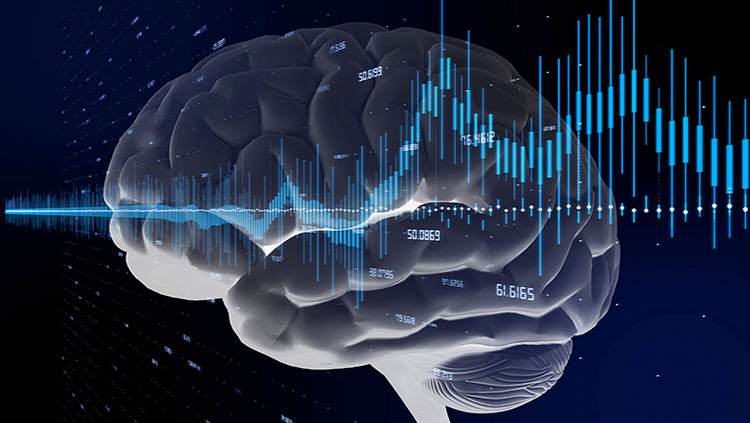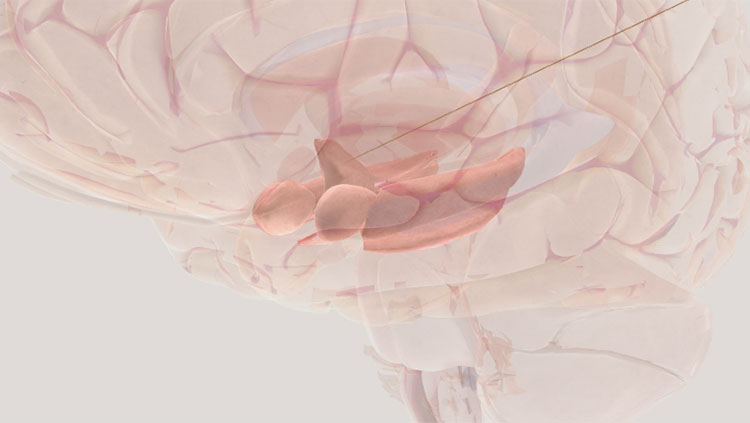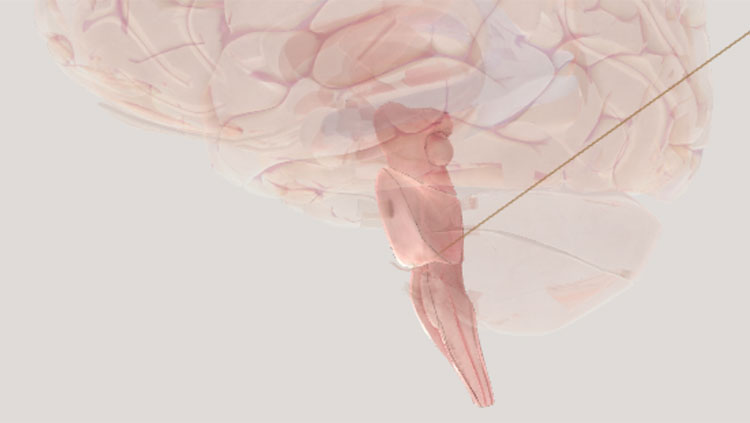How the Brain Changes With Age
- Reviewed30 Aug 2019
- Author Alexis Wnuk
- Source BrainFacts/SfN

Our bodies change in noticeable ways as we age. Our hair grays, our skin wrinkles and loses its elasticity. Less obvious are the changes happening in our brains.
Much like muscles and joints, certain cells in our brains can stiffen up too, as evidenced in a recent study in mice. This is just one of many ways our brains change as we age – from declines in memory and cognitive abilities, all the way down to microscopic changes to brain cells and chemistry.>
Cognitive Changes
The normal aging process brings subtle changes in cognitive abilities. Committing new information to memory and recalling names and numbers can take longer. Autobiographical memory of life events and accumulated knowledge of learned facts and information – both types of declarative memory – decline with age, whereas procedural memories like remembering how to ride a bike or tie a shoe remain largely intact.
Working memory — the ability to hold a piece of information in mind, such as a phone number, password, or the location of a parked — also declines with age. Some studies suggest a slow decline starts as early as age 30. Working memory depends on the rapid processing of new information rather than on stored knowledge. Other aspects of this kind of fluid intelligence, such as processing speed and problem-solving, also decrease with age.
Certain aspects of attention can become more difficult as our brains age. We may have a harder time focusing on what our friends are saying when we’re in a noisy restaurant. Our ability to tune out distractions and focus on a particular stimulus is called selective attention. Splitting our focus between two tasks – like holding a conversation while driving – also becomes more challenging with age. This type of attention is called divided attention.>
But it’s not all downhill after age 30. In fact, certain cognitive abilities improve in middle age: the Seattle Longitudinal Study, which tracked the cognitive abilities of thousands of adults over the past 50 years, showed people actually performed better on tests of verbal abilities, spatial reasoning, math, and abstract reasoning in middle age than they did when they were young adults.
Contrary to the adage that you can’t teach an old dog new tricks, there is growing evidence that we can and do learn throughout our lives. Neuroscientists are learning our brains remain relatively “plastic” as we age, meaning they’re able to reroute neural connections to adapt to new challenges and tasks.
Structural Changes
All of these alterations in cognitive ability reflect changes in the brain’s structure and chemistry. As we enter midlife, our brains change in subtle but measurable ways. The overall volume of the brain begins to shrink when we’re in our 30s or 40s, with the rate of shrinkage increasing around age 60.
But, the volume loss isn’t uniform throughout the brain — some areas shrink more, and faster, than other areas. The prefrontal cortex, cerebellum, and hippocampus show the biggest losses, which worsen in advanced age.
Our cerebral cortex, the wrinkled outer layer of the brain containing neuron cell bodies, also thins as we age. Cortical thinning follows a pattern similar to volume loss and is especially pronounced in the frontal lobes and parts of the temporal lobes.
The areas of the brain that experience the most dramatic changes with age are also among the last to mature in adolescence. This has led scientists to propose a “last in, first out” theory of brain aging – the last parts of the brain to develop are the first to deteriorate. Studies of age-related changes to white matter support this hypothesis. The first of the brain’s long-distance fibers to develop are the projection fibers connecting the cortex to lower parts of the brain and spinal cord. Fibers connecting diffuse areas within a single hemisphere — called association fibers — are the last to reach maturity and show the steepest functional declines with age.
Neuronal Changes
Changes at the level of individual neurons contribute to the shrinkage and cortical thinning of the aging brain. Neurons shrink and retract their dendrites, and the fatty myelin that wraps around axons deteriorates. The number of connections, or synapses, between brain cells also drops, which can affect learning and memory.
Although synaptic changes are selective and subtle, their effect on cognitive decline is believed to be greater than the effects of structural and chemical changes. In the prefrontal cortex and hippocampus, scientists have observed alterations in dendrites, the branched extensions of nerve cells that receive signals from other neurons. With increasing age, dendrites shrink, their branches become less complex, and they lose dendritic spines, the tiny protuberances that receive chemical signals.
In a study of rhesus monkeys, scientists found the aging process targets a certain class of spines called thin spines. These small, slender protuberances are also highly plastic structures, extending and retracting much more rapidly than the larger “mushroom” class of spines. This has led scientists to speculate that thin spines might be involved in working memory, which requires a high degree of synaptic plasticity. The loss of thin dendritic spines could impair neuronal communication and contribute to cognitive decline.
Finally, the formation of new neurons — a process called neurogenesis — also declines with age. Although scientists once thought neurogenesis came to a halt after birth, we now know that two brain regions continue to add new neurons throughout life: the olfactory bulbs and the dentate gyrus of the hippocampus. But the jury is still out on these findings — in a 2018 study, researchers failed to find any evidence of new neurons in adult brains. They suggested neurogenesis is rare in adults or that it happens to such a small degree that it’s undetectable. And, even if new neurons do appear later in life, scientists don’t know if they could integrate into long-established brain networks or affect cognition. Still, studies in mice have found that strategies to boost neurogenesis, such as regular exercise, can improve cognitive function.
Chemical Changes
As we age, our brains may also generate fewer chemical messengers. Several studies have reported that older brains synthesize less dopamine, and there are fewer receptors to bind the neurotransmitter. One study found 60- and 70-year-olds with mild cognitive impairment had less serotonin in their brains, and the researchers wondered whether manipulating serotonin levels might help prevent and treat memory loss.
Our brains undergo myriad changes during the aging process. However, scientists are learning every day how adopting a healthy lifestyle can delay or minimize the negative consequences of these changes.
This article was adapted from the 8th edition of Brain Facts by Alexis Wnuk.
CONTENT PROVIDED BY
BrainFacts/SfN
References
Bender, A. R., Völkle, M. C., & Raz, N. (2016). Differential aging of cerebral white matter in middle-aged and older adults: A seven-year follow-up. NeuroImage, 125, 74–83. doi: 10.1016/j.neuroimage.2015.10.030
Burke, S. N., & Barnes, C. A. (2006). Neural plasticity in the ageing brain. Nature Reviews. Neuroscience, 7(1), 30–40. doi: 10.1038/nrn1809
Dickstein, D. L., Weaver, C. M., Luebke, J. I., & Hof, P. R. (2013). Dendritic spine changes associated with normal aging. Neuroscience, 251, 21–32. doi: 10.1016/j.neuroscience.2012.09.077
Fjell, A. M., Westlye, L. T., Amlien, I., Espeseth, T., Reinvang, I., Raz, N., … Walhovd, K. B. (2009). High consistency of regional cortical thinning in aging across multiple samples. Cerebral Cortex (New York, N.Y.: 1991), 19(9), 2001–2012. doi: 10.1093/cercor/bhn232
Harada, C. N., Natelson Love, M. C., & Triebel, K. L. (2013). Normal cognitive aging. Clinics in Geriatric Medicine, 29(4), 737–752. doi: 10.1016/j.cger.2013.07.002
Hedman, A. M., van Haren, N. E. M., Schnack, H. G., Kahn, R. S., & Hulshoff Pol, H. E. (2012). Human brain changes across the life span: A review of 56 longitudinal magnetic resonance imaging studies. Human Brain Mapping, 33(8), 1987–2002. doi: 10.1002/hbm.21334
Hof, P. R., & Morrison, J. H. (2004). The aging brain: Morphomolecular senescence of cortical circuits. Trends in Neurosciences, 27(10), 607–613. doi: 10.1016/j.tins.2004.07.013
Jernigan, T. L., Archibald, S. L., Fennema-Notestine, C., Gamst, A. C., Stout, J. C., Bonner, J., & Hesselink, J. R. (2001). Effects of age on tissues and regions of the cerebrum and cerebellum. Neurobiology of Aging, 22(4), 581–594. Retrieved from https://www.ncbi.nlm.nih.gov/pubmed/11445259
Kaasinen, V., Vilkman, H., Hietala, J., Någren, K., Helenius, H., Olsson, H., … Rinne, J. (2000). Age-related dopamine D2/D3 receptor loss in extrastriatal regions of the human brain. Neurobiology of Aging, 21(5), 683–688. Retrieved from https://www.ncbi.nlm.nih.gov/pubmed/11016537
Kuhn, H. G., Dickinson-Anson, H., & Gage, F. H. (1996). Neurogenesis in the dentate gyrus of the adult rat: Age-related decrease of neuronal progenitor proliferation. Journal of Neuroscience, 16(6), 2027–2033. doi: 10.1523/JNEUROSCI.16-06-02027.1996
Kumakura, Y., Vernaleken, I., Buchholz, H.-G., Borghammer, P., Danielsen, E., Gründer, G., … Cumming, P. (2010). Age-dependent decline of steady state dopamine storage capacity of human brain: An FDOPA PET study. Neurobiology of Aging, 31(3), 447–463. doi: 10.1016/j.neurobiolaging.2008.05.005
Meltzer, C. C., Smith, G., DeKosky, S. T., Pollock, B. G., Mathis, C. A., Moore, R. Y., … Reynolds, C. F. (1998). Serotonin in aging, late-life depression, and Alzheimer’s disease: The emerging role of functional imaging. Neuropsychopharmacology: Official Publication of the American College of Neuropsychopharmacology, 18(6), 407–430. doi: 10.1016/S0893-133X(97)00194-2
Morrison, J. H., & Baxter, M. G. (2012). The Aging Cortical Synapse: Hallmarks and Implications for Cognitive Decline. Nature Reviews. Neuroscience, 13(4), 240–250. doi: 10.1038/nrn3200
Nilsson, L.-G., Sternäng, O., Rönnlund, M., & Nyberg, L. (2009). Challenging the notion of an early-onset of cognitive decline. Neurobiology of Aging, 30(4), 521–524; discussion 530-533. doi: 10.1016/j.neurobiolaging.2008.11.013
Ota, M., Yasuno, F., Ito, H., Seki, C., Nozaki, S., Asada, T., & Suhara, T. (2006). Age-related decline of dopamine synthesis in the living human brain measured by positron emission tomography with L-[beta-11C]DOPA. Life Sciences, 79(8), 730–736. doi: 10.1016/j.lfs.2006.02.017
Raz, N., Lindenberger, U., Rodrigue, K. M., Kennedy, K. M., Head, D., Williamson, A., … Acker, J. D. (2005). Regional brain changes in aging healthy adults: General trends, individual differences and modifiers. Cerebral Cortex (New York, N.Y.: 1991), 15(11), 1676–1689. doi: 10.1093/cercor/bhi044
Salthouse, T. A. (2009). When does age-related cognitive decline begin? Neurobiology of Aging, 30(4), 507–514. doi: 10.1016/j.neurobiolaging.2008.09.023
Sowell, E. R., Peterson, B. S., Thompson, P. M., Welcome, S. E., Henkenius, A. L., & Toga, A. W. (2003). Mapping cortical change across the human life span. Nature Neuroscience, 6(3), 309–315. doi: 10.1038/nn1008
Spalding, K. L., Bergmann, O., Alkass, K., Bernard, S., Salehpour, M., Huttner, H. B., … Frisén, J. (2013). Dynamics of hippocampal neurogenesis in adult humans. Cell, 153(6), 1219–1227. doi: 10.1016/j.cell.2013.05.002
Yin, J.-A., Liu, X.-J., Yuan, J., Jiang, J., & Cai, S.-Q. (2014). Longevity manipulations differentially affect serotonin/dopamine level and behavioral deterioration in aging Caenorhabditis elegans. The Journal of Neuroscience: The Official Journal of the Society for Neuroscience, 34(11), 3947–3958. doi: 10.1523/JNEUROSCI.4013-13.2014
What to Read Next
Also In Aging
Trending
Popular articles on BrainFacts.org








.jpg)










